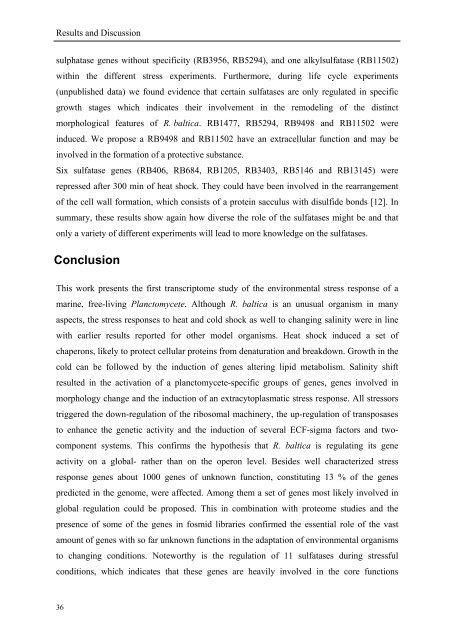a Whole Genome Array Approach - Jacobs University
a Whole Genome Array Approach - Jacobs University
a Whole Genome Array Approach - Jacobs University
You also want an ePaper? Increase the reach of your titles
YUMPU automatically turns print PDFs into web optimized ePapers that Google loves.
Results and Discussion<br />
sulphatase genes without specificity (RB3956, RB5294), and one alkylsulfatase (RB11502)<br />
within the different stress experiments. Furthermore, during life cycle experiments<br />
(unpublished data) we found evidence that certain sulfatases are only regulated in specific<br />
growth stages which indicates their involvement in the remodeling of the distinct<br />
morphological features of R. baltica. RB1477, RB5294, RB9498 and RB11502 were<br />
induced. We propose a RB9498 and RB11502 have an extracellular function and may be<br />
involved in the formation of a protective substance.<br />
Six sulfatase genes (RB406, RB684, RB1205, RB3403, RB5146 and RB13145) were<br />
repressed after 300 min of heat shock. They could have been involved in the rearrangement<br />
of the cell wall formation, which consists of a protein sacculus with disulfide bonds [12]. In<br />
summary, these results show again how diverse the role of the sulfatases might be and that<br />
only a variety of different experiments will lead to more knowledge on the sulfatases.<br />
Conclusion<br />
This work presents the first transcriptome study of the environmental stress response of a<br />
marine, free-living Planctomycete. Although R. baltica is an unusual organism in many<br />
aspects, the stress responses to heat and cold shock as well to changing salinity were in line<br />
with earlier results reported for other model organisms. Heat shock induced a set of<br />
chaperons, likely to protect cellular proteins from denaturation and breakdown. Growth in the<br />
cold can be followed by the induction of genes altering lipid metabolism. Salinity shift<br />
resulted in the activation of a planctomycete-specific groups of genes, genes involved in<br />
morphology change and the induction of an extracytoplasmatic stress response. All stressors<br />
triggered the down-regulation of the ribosomal machinery, the up-regulation of transposases<br />
to enhance the genetic activity and the induction of several ECF-sigma factors and twocomponent<br />
systems. This confirms the hypothesis that R. baltica is regulating its gene<br />
activity on a global- rather than on the operon level. Besides well characterized stress<br />
response genes about 1000 genes of unknown function, constituting 13 % of the genes<br />
predicted in the genome, were affected. Among them a set of genes most likely involved in<br />
global regulation could be proposed. This in combination with proteome studies and the<br />
presence of some of the genes in fosmid libraries confirmed the essential role of the vast<br />
amount of genes with so far unknown functions in the adaptation of environmental organisms<br />
to changing conditions. Noteworthy is the regulation of 11 sulfatases during stressful<br />
conditions, which indicates that these genes are heavily involved in the core functions<br />
36

















